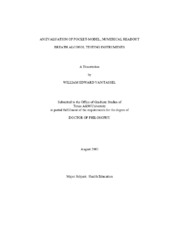| dc.contributor.advisor | Dennis, Maurice E. | |
| dc.creator | Van Tassel, William Edward | |
| dc.date.accessioned | 2004-11-15T19:48:11Z | |
| dc.date.available | 2004-11-15T19:48:11Z | |
| dc.date.created | 2003-08 | |
| dc.date.issued | 2004-11-15 | |
| dc.identifier.uri | https://hdl.handle.net/1969.1/1159 | |
| dc.description.abstract | Eight small-scale breath alcohol measurement devices were tested for accuracy, precision and the ability to not yield false positive and false negative readings. These pocket-sized breath testers (PMBTs), which provided numerical readout of BrAC to the 100th of a percent, were smaller than evidential and preliminary breath test instruments (EBTs and PBTs). The smallest devices were approximately the same size of a cigarette lighter. Designed to provide drinkers feedback about their individual alcohol levels, the PMBTs ranged in price from $40-100 USD.
The devices were first tested under laboratory conditions with alcohol solution simulators providing the alcoholic samples. They were then tested with human drinkers, under controlled field conditions. Each device was tested at multiple alcohol levels.
Two of the eight PMBTs failed to complete all levels of testing and were excluded from the study. All PMBTs demonstrated the ability to not yield false positive and false negative readings. No device met NHTSA performance criteria for accuracy (systematic error) in testing EBTs at every alcohol level tested. An interaction between PMBTs and the alcohol test levels was found. Thus, accuracy was found to be dependent upon the alcohol level at which the devices were tested. No device met NHTSA performance criteria for precision in testing EBTs at every alcohol level tested. Precision varied depending on the testing condition. There was less precision under controlled field conditions than under laboratory conditions. Five of the six PMBTs that completed the testing overestimated BrAC; only one device read below actual BrAC.
Ramifications of the findings are discussed, regarding the overestimation and underestimation of BrAC and the possibility of manufacturers intentionally calibrating the devices to overestimate BrAC. Potential PMBT users are discussed and areas for future research are addressed. | en |
| dc.format.extent | 757794 bytes | en |
| dc.format.extent | 216334 bytes | en |
| dc.format.medium | electronic | en |
| dc.format.mimetype | application/pdf | |
| dc.format.mimetype | text/plain | |
| dc.language.iso | en_US | |
| dc.publisher | Texas A&M University | |
| dc.subject | breath alcohol | en |
| dc.subject | portable alcohol | en |
| dc.subject | portable tester | en |
| dc.subject | personal alcohol | en |
| dc.subject | personal test | en |
| dc.subject | pocket-model alcohol | en |
| dc.subject | pocket model | en |
| dc.subject | pocket-model breath | en |
| dc.subject | hand-held alcohol | en |
| dc.subject | alcohol test | en |
| dc.subject | BrAC | en |
| dc.subject | BAC | en |
| dc.title | An evaluation of pocket-model, numerical readout breath alcohol testing instruments | en |
| dc.type | Book | en |
| dc.type | Thesis | en |
| thesis.degree.department | Health and Kinesiology | en |
| thesis.degree.discipline | Health Education | en |
| thesis.degree.grantor | Texas A&M University | en |
| thesis.degree.name | Doctor of Philosophy | en |
| thesis.degree.level | Doctoral | en |
| dc.contributor.committeeMember | Pruitt, Buster E. | |
| dc.contributor.committeeMember | Brackett, R. Quinn | |
| dc.contributor.committeeMember | Stenning, Walter F. | |
| dc.type.genre | Electronic Dissertation | en |
| dc.type.material | text | en |
| dc.format.digitalOrigin | born digital | en |


